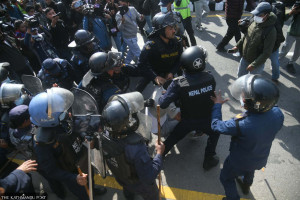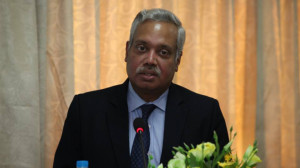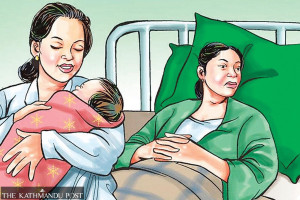National
Following the World Bank, Central Bureau of Statistics too revises growth rate to 2.27
The revision is a sharp fall from 8.5 percent that the government had set for the economy this year, but even a 2.27 growth is optimistic, economists say.
Sangam Prasain
Taking the myriad effects of the ongoing Covid-19 pandemic into account, the Central Bureau of Statistics has revised the growth of Nepal’s economy to 2.27 percent this fiscal year, a sharp drop from the 8.5 percent that the government had initially set for itself.
This will mark the slowest pace of economic expansion in four years, the Central Bureau of Statistics said on Wednesday. The bureau’s revision follows the World Bank’s prediction that Nepal’s growth rate will be in the range of 1.5 to 2.8 percent in 2019-20.
“The current growth has been based on a projection that the lockdown will be lifted by mid-June and all manufacturing and production activities, except for international travel and tourism, resume operations by then,” said Ishwori Prasad Bhandari, director of the National Economic Statistics Division at the Central Bureau of Statistics. “We have assumed growth slowdown may bottom out by mid-July and that the economy could see a gradual recovery in the next fiscal year, driven by revivals in consumption when hotels and restaurants will be opened.”
Bhandari, however, warned that the outlook could be bleaker if the lockdown is extended beyond mid-June and international travel restrictions are not lifted globally. The Central Bureau of Statistics is also working to ascertain the actual losses caused by Covid-19 to the national economy, he said.
Releasing the preliminary annual National Accounts Statistics of Nepal 2019-20, the Central Bureau of Statistics, the government’s central statistical body, said that a 2.27 percent growth translates to a gross domestic product of about Rs3.76 trillion. With this GDP, the per capita income of Nepalis will reach $1,085 this fiscal year, up from $1,039 last year. For the last three years, Nepal had achieved a growth rate of over 6 percent.
The contribution of workers' remittances as a percentage of GDP is expected to drop to 19 percent this fiscal year, compared to 25.42 percent last fiscal year, the bureau said.
Remittance to Nepal is expected to drop by a whopping 14 percent in 2020, signalling economic distress stemming from the Covid-19 pandemic, according to a recent World Bank report.
This drop in remittance roughly translates to a loss of Rs145 billion, based on the current exchange rate of $1=Rs120.
Nepali migrant workers sent home $8.64 billion in 2019, making the country one of the biggest beneficiaries of remittance in the world.
The National Accounts Statistics report shows that the contribution of the primary sector, which includes agriculture, fisheries, forestry and mining, to the GDP will be 28.20 percent, with a growth rate of 2.54 percent. The drop in summer paddy production and measures adopted to prevent the spread of Covid-19 have resulted in a breakdown in the supply chain, adversely affecting the sector’s growth.
As a result, the agriculture sector, which grew over 5 percent last fiscal year, slowed to 2.59 percent this fiscal year.
The secondary sector, which includes construction, industry, electricity, water and gas, contributes 13.72 percent to the national economy and has been expected to grow by 3.36 percent this fiscal year.
The tertiary service sector, which contributes 58 percent to the GDP, is expected to slow, growing by a meager 1.99 percent. The slowdown is the result of restrictions in domestic and international travel and impacts on the hotel and restaurant sector, the bureau said. The growth rate of hotels and restaurants in the GDP has been expected to be negative 16.30 percent this fiscal year. The transportation sector is also expected to see a negative growth rate.
Economists, however, say that the revised growth of 2.27 percent is still optimistic.
“We have yet to face an unemployment problem as many countries could stop hiring people due to the looming global financial crisis,” said economist Bishwambher Pyakuryal. “It’s a v-shaped recession, where economic decline is steep and it takes months to rebound.”
Pyakuryal was referring to the millions of Nepalis who are currently employed in foreign countries. When those economies go into a recession, there will likely be job losses, leading to tens of thousands of Nepalis returning home.
According to Pyakuryal, even developed countries with good health and economic infrastructure have projected that it will take between 7 and 14 months to rebound.
“So we should not be too optimistic,” he said.
Things are worse for a country like Nepal as the Covid-19 pandemic hit at a time of major economic activity.
“Mid-January to mid-February is the period during which economic activities pick up pace in the country,” said economist Chandan Sapkota. “But to contain the spread of the virus, the government resorted to measures like strict lockdowns and social distancing, thereby putting a halt to all economic activities.”
Given the current situation, Sapkota too agreed that the growth projection was optimistic.
“The bureau expects lockdowns to loosen and economic activities to gradually normalise,” said Sapkota. “However, this may be challenging because of the disruption to labour and supplies markets and subdued consumer demand. For instance, the dispersal of labour [both internal and external migrant workers] will be difficult to reverse quickly.”
Private sector investment could also remain subdued, given uncertainties and the additional cost to businesses due to the lockdown.
“Some might simply go out of business and default on loan payments,” he said.
The upcoming budget, which is due on May 29, should come up with a plan to address all of these issues, said Pyakuryal.
“The subsistence agriculture system will not work,” he said. “There should be drastic measures to revive the agriculture sector by engaging the migrant workers who return home.”




 17.12°C Kathmandu
17.12°C Kathmandu















